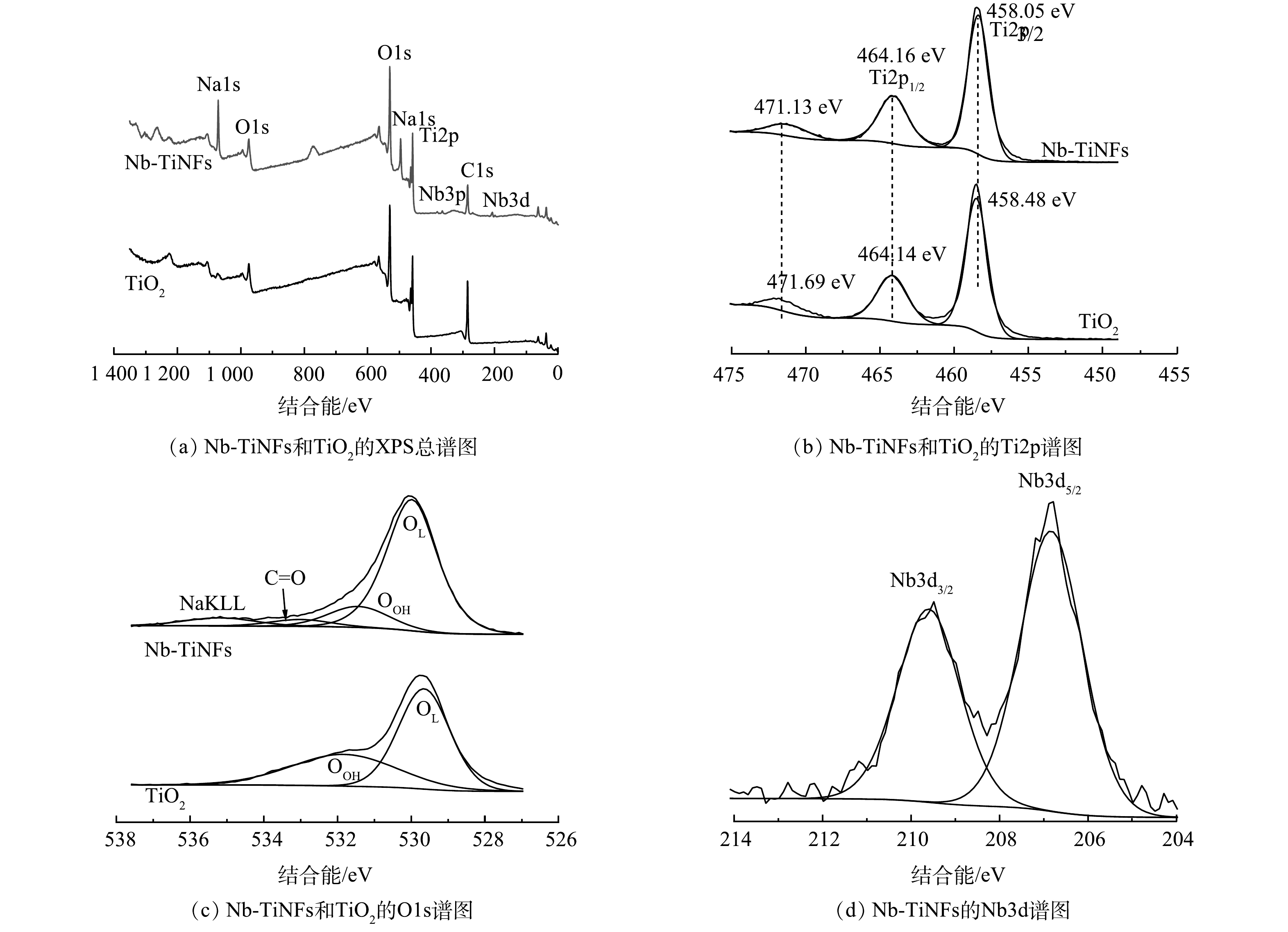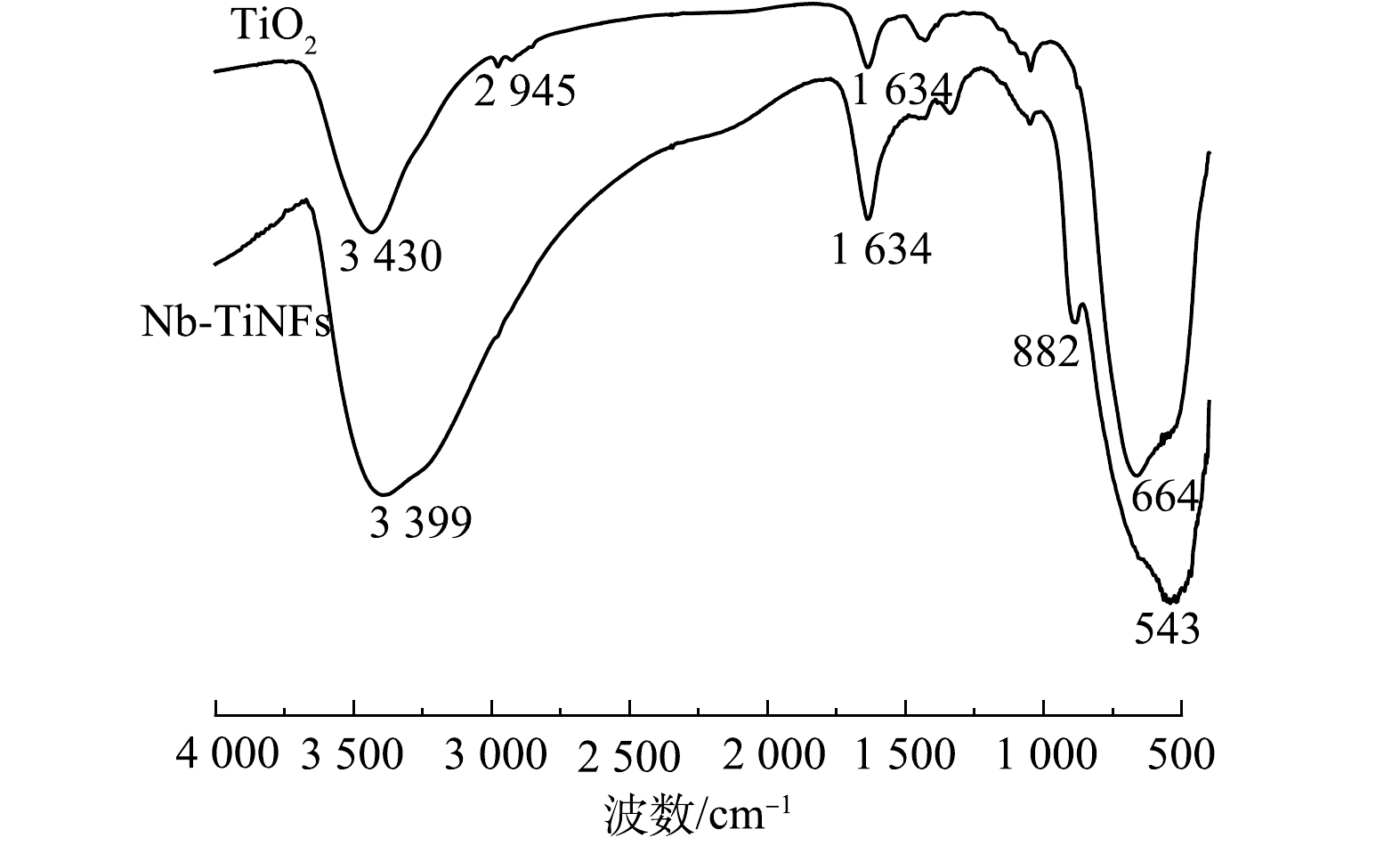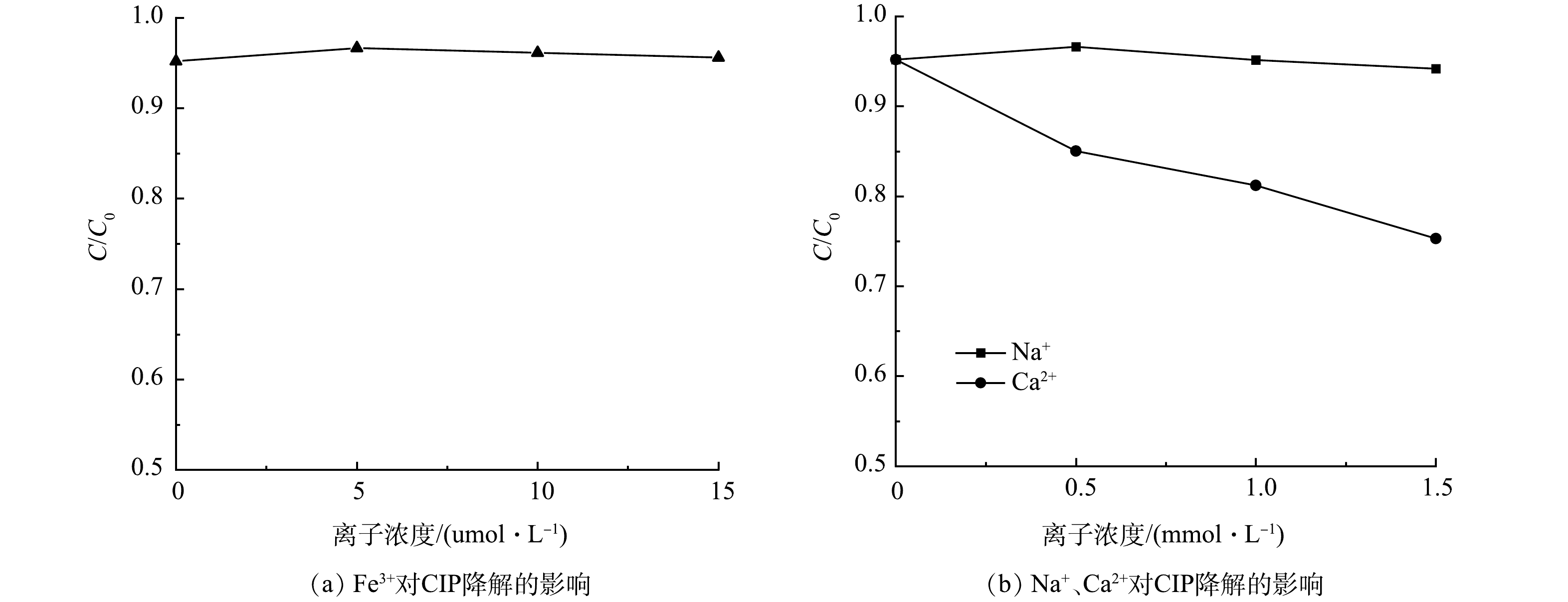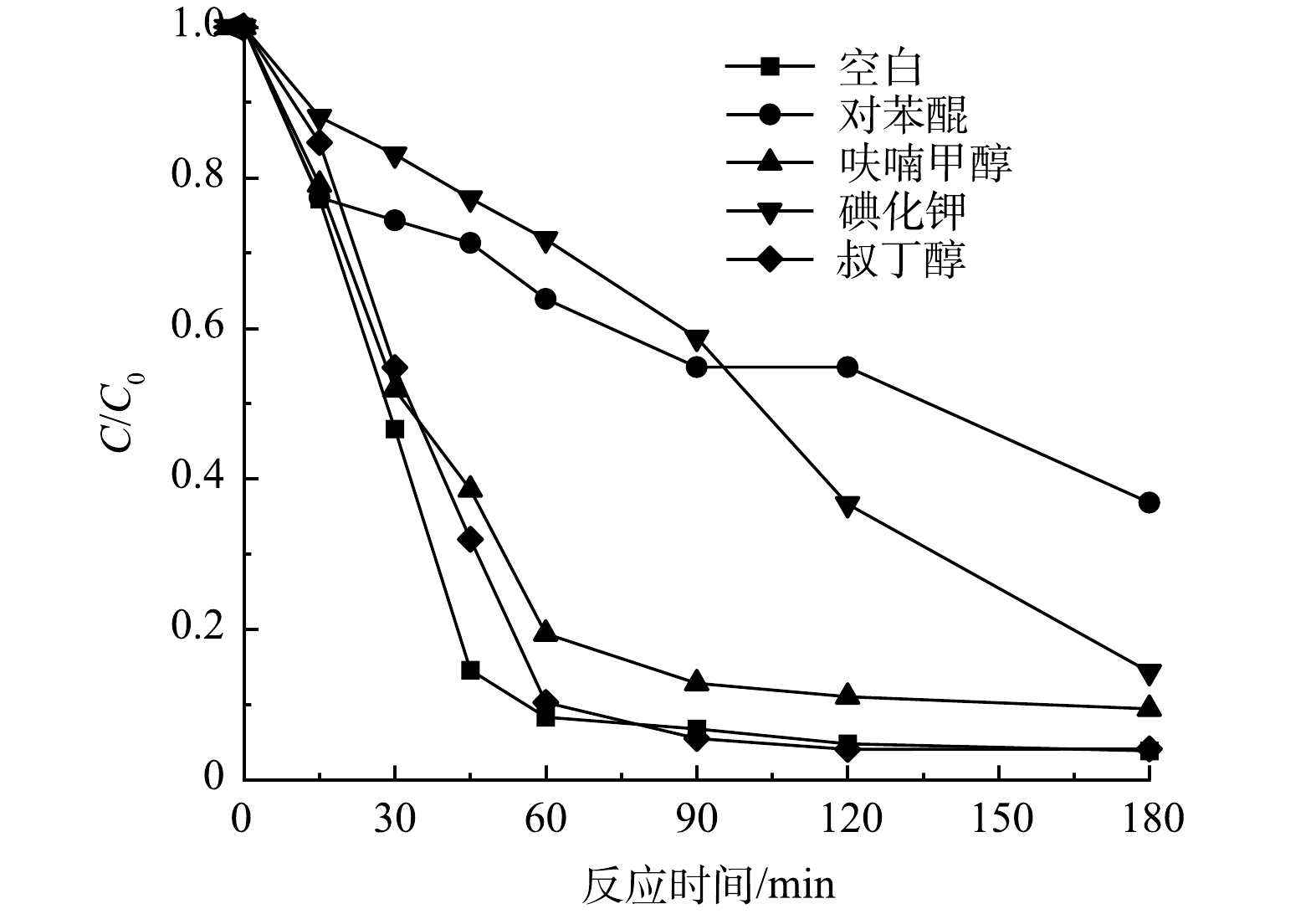-
抗生素作为一类新兴的药物和个人护理产品(pharmaceutical and personal care products,PPCPs)[1-2],被广泛用于治疗和预防人体、畜禽和水产品的疾病和细菌性病害。近年来,由于新兴冠状病毒肺炎(corona virus disease 2019,COVID-19)疫情的爆发,世界各地抗生素的使用急剧增加[3],由抗生素类毒物引起的水生环境污染问题也已成为全世界备受关注的问题[4]。
由于抗生素类药物分子结构稳定,被食用后不易被生物体完全吸收,会以代谢活性产物甚至原结构形式排出体外进而释放到环境中[5-6]。此外,未使用或过期的药物以及生产废水的不当处理使更多的抗生素进入自然水系统中,包括饮用水源[7-8]。据估计,2013年共有53 800 t抗生素被释放到中国的河流和水道中[9]。联合国的“2017年前沿报告”指出,水产养殖中75%的抗生素可能会流失到周围环境中[10],这对生态系统和人类健康均存在潜在的威胁[11-12]。因此,对水体中抗生素的去除很有必要。然而,常规水处理工艺对这类痕量污染物去除效果有限[13-14],一些深度处理技术例如膜处理技术、臭氧技术、吸附技术、电化学氧化技术等,在处理抗生素时虽然可以实现一定程度的降解[15],但存在着处理费用高、操作过程复杂、稳定性低、再循环能力差等问题,这也对世界各国抗生素污水的处理提出了新的挑战。
近年来,基于TiO2的光催化技术由于其有效性、低成本、高稳定性和环境友好性被广泛用于光催化降解含抗生素类废水。将TiO2纳米粒子通过水热处理制备得到的钛酸纳米材料(titanate nanomaterials,TNM)通常具有较大的比表面积和精细的纳米级结构,具有良好的去除多种污染物的性能[16]。但是,由于纳米TiO2光催化剂的带隙(Eg)(3.2~3.4 eV)较大,只对波长低于380 nm的紫外光有响应,以及快速的电子-空穴对复合速率,使得TiO2和TNM的可见光响应较弱,从而限制了其在太阳/可见光下的应用[17-18]。因此,开发新兴、高效的催化剂成为近年来研究的热点。研究人员利用将光催化剂与金属和非金属掺杂、设计和构建异质结等方法,合成了大量的TiO2基光催化材料[19],并应用于对水体中各类有机污染物的高效去除。
本研究中通过将铌酸盐作为光反应促进剂掺入钛酸盐中,水热法合成一类新型片状纳米复合材料-铌酸盐/钛酸钠米片(niobate/titanate nanoflakes,Nb-TiNFs),利用 XRD、XPS、FT-IR、SEM、TEM等多种手段对Nb-TiNFs材料进行表征和分析。选取氟喹诺酮类抗生素的代表环丙沙星(ciprofloxacin,CIP)作为目标污染物,探究了Nb-TiNFs在模拟日光下对水中CIP的光催化性能和机理,以期为光催化降解水中新兴有机污染物提供参考。
-
试剂:二氧化钛(TiO2(P25),德国Degussa 公司)、五氧化二铌(Nb2O5,国药集团化学试剂有限公司)、环丙沙星(C17H18FN3O3,上海阿拉丁试剂)、对苯醌(C6H4O2,天津市清华津英科技有限公司)、碘化钾(KI,天津市北联精细化学品开发有限公司)、叔丁醇(C4H10O,天津市恒兴化学试剂制造有限公司)、呋喃甲醇(C5H6O2,上海吉至生化科技有限公司)、无水乙醇(CH3CH2OH,天津市富宇精细化工有限公司)、氢氧化钠(NaOH,上海阿拉丁试剂)、盐酸(HCl,国药控股有限公司),氯化钠(NaCl,天津市大茂化学试剂厂)、氯化钙(CaCl2,天津市恒兴化学试剂制造有限公司)、氯化铁(FeCl3,上海吉至生化科技有限公司)均为分析纯,乙腈(C2H3N,赛默飞世尔科技(中国)有限公司)、甲酸(CH2O2,赛默飞世尔科技(中国)有限公司)均为色谱纯。
仪器:电子分析天平(BSA224S,赛多利斯科学仪器(北京)有限公司),pH计(FE28,梅特勒-托利多仪器(上海)有限公司),高速离心机(KH20R,湖南凯达科学仪器有限公司),磁力搅拌器(78-1,常州荣华仪器制造有限公司),电热鼓风干燥箱(GZX-9023MBE,上海博讯实业有限公司医疗设备厂),300W氙灯弧光灯光源(Microsolar 300W 氙灯光源,泊菲莱),Zeta电位仪(Nano-ZS90,英国Malvern Instruments公司),X射线衍射仪(XRD)(D8 ADVANCE,德国Bruker公司),热场发射扫描电镜(SEM)(JSM-7001F,日本电子株式会社),高分辨透射电子显微镜(TEM)(JEM-2010,日本电子株式会社),X射线光电子能谱仪(XPS)(Thermo Scientific K-Alpha),傅里叶红外光谱仪(IRTracer-100 光谱仪,日本岛津),高效液相色谱法(HPLC,Agilent 1260,美国)。
-
采用一步水热法合成Nb-TiNFs纳米材料,具体步骤为:首先将0.8 g TiO2和0.2 g Nb2O5投加到66.7 mL的NaOH (10.0 mol·L−1 ) 溶液中,于25 ℃下放置于磁力搅拌器(500 r·min−1)上搅拌12 h。接着将混合均匀的溶液移入到100 mL的聚四氟乙烯内衬中,随后放置于不锈钢反应釜中,并置于烘箱中 (130 °C) 进行水热处理。72 h后,将反应釜自然冷却至室温,用去离子水反复洗涤几次至生成物近中性,用无水乙醇将生成物分散后置于烘箱中80 °C烘干,研磨备用。
-
使用X射线衍射仪(XRD)对制备好的Nb-TiNFs进行晶体结构分析测定。将样品粉末用KBr压片法制成样品试片,在X射线衍射仪上检测产物的晶型,扫描范围2θ为10°~80°,扫描速度为4°·min−1。
使用扫描电镜(SEM)和透射电镜(TEM)对制备好的Nb-TiNFs进行形貌和微观结构分析;使用 X 射线光电子能谱法(XPS)表征表面化学组成,辐射源为单色 Al 的 Kl 射线,所有的结合能都以284.8 eV 的外来碳信号做内标进行校正以消除静电效应;使用傅里叶红外光谱仪测量样品的傅里叶变换红外光谱(FT-IR),以 KBr 为背景,制样中 KBr 与样品质量比为 100∶1,扫描范围为 400~4 000 cm−1;使用Zeta电位仪测量不同pH下的Zeta电位,将样品按照0.2 g·L−1的比例投入超纯水中制成悬浊液,用0.1 mol·L−1 HCl或0.1 mol·L−1 NaOH调节溶液pH,将确定pH的悬浊液注入Zeta电位仪的测量池,进行测量。
-
环丙沙星光催化降解实验在300W氙灯弧光灯光源下模拟太阳光(AM1.5模式)进行。称量0.015 g的催化剂,将其分散于150 mL 10 mg·L−1环丙沙星溶液中,用0.1 mol·L−1氢氧化钠和盐酸溶液调整pH。首先,将混合溶液在避光条件下搅拌30 min,使CIP在光催化剂上达到吸附平衡。然后,将反应器置于氙灯光源下,在预设时间间隔取样,样品过 0.22 μm 尼龙滤膜,用高效液相色谱仪测定滤液中CIP浓度。整个实验过程中采用循环冷却水装置以控制反应器温度为(25±1) °C。此外,在高效液相色谱法中使用ZORBAX SB-C18柱(250 mm×4.6,5 µm),柱温40°C,荧光检测器激发波长280 nm,发射波长450 nm。流动相体积分数为85%甲酸水(甲酸比例为0.1%),15%乙腈,流动相流速为0.25 mL·min−1,反应时间为240 min。CIP的降解率根据式(1)进行计算。
式中:D为降解率,%;C0是CIP的初始浓度,mg·L−1;Ct是t时刻CIP的浓度,mg·L−1。
-
配置初始质量浓度为10 mg·L−1的环丙沙星溶液(150 mL),投加15 mgNb-TiNFs(催化剂质量浓度为0.1 g·L−1),用0.01 mol·L−1的 HCl 和 NaOH 溶液将反应体系的初始 pH 调节为2、4、6和8。经氙灯光源照射在预设时间间隔取样,过膜待测。
-
配置初始质量浓度为10 mg·L−1的环丙沙星溶液(150 mL),加入不同浓度水中常见无机离子(Na+、Ca2+和Fe3+)溶液,投加15 mg Nb-TiNFs(催化剂质量浓度为0.1 g·L−1),调节溶液pH为6。氙灯光源照射过程中在预设时间间隔取样,过膜待测。其中,Na+、Ca2+浓度分别设0.5、1和1.5 mmol·L−1三个梯度,Fe3+浓度设0.5、1和1.5 µmol·L−1,总反应时长为180 min。
-
利用对苯醌(BQ)、碘化钾(KI)、呋喃甲醇(FA)和树丁醇(TBA)分别作为超氧自由基(·O2-),空穴(h+),单线态氧(1O2)和羟基自由基(·OH)的淬灭剂 ,考察不同可能存在的活性物种对环丙沙星去除率和降解速率的影响。在光催化反应开始前,加入活性物种淬灭剂 (0.01 mol·L−1 ) ,在设定时间取样过膜后检测。
-
配置环丙沙星初始质量浓度为10 mg·L−1, Nb-TiNFs为0.1 g·L−1的溶液,调节pH为6,在氙灯光源照射下预设时间取样,过膜待测。180 min反应结束后,混合溶液经0.22 µm水系滤膜真空抽滤,将滤得的粉末纯水清洗、烘干后重复利用。通过 5 次连续循环实验探究材料的可重复利用性能。
-
Nb-TiNFs的XRD表征结果如图1所示。可见,在2θ为24°、28°、48°、62°处的特征衍射峰说明Nb-TiNFs为钛酸钠的晶型,可用化学式Na2H2-xTi3O7 .n H2O表示(x取决于钠含量)[20]。因此,水热合成后生成的Nb-TiNFs主体为钛酸盐,该钛酸盐由三重的[TiO6]八面体(骨架)和层间可交换的Na+/H+组成[20-21]。另外,在Nb-TiNFs的XRD图谱中未检测到铌酸盐的特征峰。这可能是掺入铌的量较少,铌酸盐未形成晶体结构。
Nb-TiNFs的TEM和SEM表征结果分别如图2(a)和图2(b)所示。由图2(a)可以看出,复合材料呈现清晰的片状结构,可见其为钛酸钠米片结构。通常情况下,P25在130 °C和72 h的水热条件下可形成钛酸纳米管[22],而片状结构一般是形成管状结构前的中间产物。本研究中未成管的原因可能是Nb2O5的掺杂影响了复合材料的最终构型[23]。由图2(b)也可以看出,Nb-TiNFs呈片层无序堆叠形成的块状形态。
Nb-TiNFs和TiO2 的XPS谱图如图3所示,其中,图3(a)、图3(b)、图3(c)、图3(d)中的所有信号都经过了C1s校准。由XPS总谱(图3(a))中可以看出,Nb-TiNFs的主要元素是O(60.69%)、Ti(21.14%)、Na(17.23%)、Nb(0.95%),显然,在这种合成条件(130 ℃,72 h)下,钛酸盐的产率远远高于铌酸盐。在Ti2p谱图(图3(b))中,结合能分别位于458.05 eV和464.16 eV的 Ti2p3/2峰和 Ti2p1/2峰表明Nb-TiNFs中的Ti为Ti4+的特征[24]。在O1s谱图(图3(c))中,TiO2具有2个特征谱峰,其中,位于低结合能529.68 eV附近的信号峰对应于晶格氧(OL),位于高结合能531.82 eV附近的信号峰对应于材料表面吸附的羟基(·OH);Nb-TiNFs材料具有4个谱峰,其中低结合能530.0 eV附近处的信号峰对应于晶格氧(OL),高结合能531.4 eV附近的信号峰对应于材料表面吸附的羟基(·OH),533.0 eV处的信号峰对应C=O键的信号峰,535.2 eV处的信号峰对应NaKLL峰。在Nb3d谱图(图3(d))中,掺杂的Nb元素的Nb 3d3/2峰和Nb 3d5/2峰均以Nb5+的形式存在[25-28]。
Nb-TiNFs和TiO2的红外图谱如图4所示,3 430 cm−1和3 399 cm−1附近的宽峰为 Ti-OH 及 吸 附 水 的—OH 伸缩振动峰,TiO2和Nb-TiNFs的峰有轻微偏移,可能是由于Nb的掺杂所导致。TiO2在2 945cm−1附近的峰为—CH2—的吸收峰,1 634 cm−1附近的峰为催化剂表面物理吸附水的H—O—H 弯曲振动峰,400~700 cm−1对应着金属氧化物键,664 cm−1 和 543 cm−1对应着Ti—O 键,882 cm−1处的峰对应着Nb—O键[29-30]。分析说明该催化剂表面存在较丰富的羟基官能团,而表面羟基有利于捕获光生空穴,生成强氧化性的羟基自由基,有利于光催化降解[31]。
Nb-TiNFs在不同pH下的Zeta电位见图5。可见,Nb-TiNFs的等电点约为2.8。当溶液 pH 为2.8时,Nb-TiNFs所带电荷为零;当溶液pH 小于等电点时,导致碱性解离小于酸性解离, 则 Nb-TiNFs的 Zeta 电位为正值;当溶液pH 大于等电点时, 导致碱性解离大于酸性解离,则 Nb-TiNFs的 Zeta 电位为负值。因此,当pH<2.8时,Nb-TiNFs的表面带正电,当pH>2.8时,Nb-TiNFs的表面带负电。
-
黑暗条件下的吸附预实验结果表明,CIP(初始质量浓度10 mg·L−1)在30min内达到吸附平衡,材料对CIP的吸附量为2.68%,可忽略不计。在光催化实验中,光催化剂的投加量是影响催化效率的1个重要因素[32]。图6反映了在CIP的初始质量浓度为10 mg·L−1,pH为6的条件下,催化剂质量浓度(0.05~0.4 g·L−1)对CIP降解的影响情况。结果表明,CIP的去除率随着光催化剂投加量的增加而升高,当催化剂质量浓度为0.05 g·L−1时,60 min内CIP的去除率为30.89%,催化剂质量浓度为0.1 g·L−1时,60 min左右CIP的去除率达到91.67%,催化剂的质量浓度增加到0.2 g·L−1和0.4 g·L−1时,60 min内去除率分别增至93.33%和96.92%。当催化剂为0.05、0.1、0.2 和0.4 g·L−1时,180 min后CIP的去除率分别为94.6%,96.1%,97.8%和98.7%。出于实际应用考虑, 0.1 g·L−1催化剂即可以满足应用需求,故之后的实验选用投加0.1 g·L−1光催化。
目标污染物的初始质量浓度也会对光催化剂的催化效率产生重要影响,为此,本研究考察了在相同催化剂浓度下不同初始质量浓度CIP的降解性能(图7)。如图7所示,当Nb-TiNFs为0.1 g·L−1、pH为6、CIP初始质量浓度为10 mg·L−1时,起初CIP被迅速降解,60 min左右即达到平衡,3 h后降解率达96%。随着CIP初始质量浓度升高,其降解率逐渐下降,当CIP质量浓度为20 mg·L−1和30 mg·L−1时,3 h后降解率分别下降至92%和56%。
为探究Nb-TiNFs在可见光驱动(visible light drive,VLD)下的降解性能,本研究使用UV滤光片(<420 nm)滤掉紫外光以考察Nb-TiNFs在可见光下对CIP的降解性能。如图8所示,在CIP初始质量浓度为10 mg·L−1,Nb-TiNFs质量浓度为0.1 g·L−1,pH为6的条件下,当使用滤光片反应180 min后,CIP的去除率由96.1%降至46.1%。因此,在日光下,可见光CIP的去除贡献为46.1%,紫外光的去除贡献为50%。如前所述,TiO2基光催化剂只对紫外光响应[17-18],而Nb-TiNFs材料对CIP的降解过程中虽然紫外光仍起着重要作用,但结果表明,铌酸盐的掺入一定程度上增强了材料的可见光驱动性能。
溶液 pH 在水处理过程中是不可忽略的因素。溶液的 pH 会影响催化剂的表面性质和污染物分子的形态分布,进而通过静电作用影响催化剂对污染物的去除[33]。同时,溶液 pH 也会影响光催化过程中活性氧物种的形成和活性,影响光催化体系的氧化能力。不同溶液 pH 对Nb-TiNFs光催化降解环丙沙星的影响情况见图9。结果表明,在CIP初始质量浓度为10 mg·L−1,Nb-TiNFs质量浓度为0.1 g·L−1的条件下,当溶液pH=2时,反应180 min后CIP的去除率最低,为87%,而当pH为4、6和8时,180 min后CIP的最终去除率分别为95.6%、96.1%、95.9%。有研究[34]表明,CIP作为一种可解离抗生素,由于其结构中的亚氨基-NH和羧基-COOH上的质子化和脱质子化过程,使其在不同的pH条件下呈现不同的存在形式,在 pH<8.7 的溶液中CIP表现为正电,在溶液 pH为 8.7~10.6 时CIP呈电中性,在溶液 pH>10.6 时CIP显示负电性。在本研究中,Nb-TiNFs的等电点为2.8,因此,溶液 pH为 2 时,Nb-TiNFs表面带正电,与CIP之间存在静电斥力,进而导致环丙沙星去除率的下降。而pH为4、6和8时,Nb-TiNFs表面带负电,CIP带正电,两者之间的静电吸引促使Nb-TiNFs能够捕获更多的CIP,从而进一步增强其降解效率。此外,随着 pH 的升高溶液中的氢氧根数量增多,为羟基自由基的产生提供了更多可能性,这也可能是引起环丙沙星去除效率升高的原因。
实际水体中普遍存在的无机阳离子可能对环丙沙星的去除产生影响[35]。本研究考察了在初始CIP质量浓度为10 mg·L−1,光催化剂质量浓度为0.1 g·L−1的条件下,水中典型Na+、Ca2+和Fe3+对Nb-TiNFs在可见光下降解CIP的影响(图10)。由图10可见,当Na+浓度在 0.5~1.5 mmol·L−1时,其对环丙沙星的光催化去除的影响微乎其微。当Na+浓度为 1.5 mmol·L−1 时,氙灯照射下120 min 后环丙沙星的去除率为 94.17%,比未加入Na+时仅降低了 1.02%。然而,当共存Ca2+浓度为0.5~1.5 mmol·L−1时,光催化120 min后,溶液中CIP降解率降低了10.2%~19.9%,抑制作用较为显著。这可能是由于带正电的 Ca2+与环丙沙星在催化剂表面竞争吸附位点,从而抑制了环丙沙星的去除。而当溶液中共存的阳离子浓度相同时, Ca2+的影响大于Na+,这可能是因为带正电的阳离子与环丙沙星在催化剂表面竞争吸附,二价阳离子的竞争力更强,此外,Ca2+与有机污染物的螯合能力较强,Ca2+可以与环丙沙星键合形成分子量较大的络合物,不利于环丙沙星在催化剂表面的吸附和光催化去除[36],考虑到常温下Fe(OH)3的溶度积Ksp为4×10−38,因此中性水体中存在的Fe3+浓度较小,故添加共存Fe3+浓度为5~15 µmol·L−1。少量共存的Fe3+可轻微促进CIP的光催化去除,当加入5 µmol·L−1 Fe3+时,可见光照射120 min后CIP的去除率由原来的95.19%升高至96.67%,这可能是因为 Fe3+的电子捕获作用进一步促进了电子和空穴的分离,有利于材料表面活性自由基的产生,但随着Fe3+浓度的增加,促进作用更加微弱,几乎可以忽略不计。
-
不同淬灭剂对环丙沙星降解速率的影响如图11所示。其中初始CIP质量浓度为10 mg·L−1,淬灭剂质量浓度为0.01 mol·L−1,pH为6。结果表明,在加入BQ、KI、FA和TBA后,光照60 min内CIP的去除率由 91.7%分别降至 36.1%、28.2%和 80.6%和89.7%,与未添加淬灭剂相比,去除率分别降低了 55.6%、63.5%和 11.1%和2%,180 min反应结束后,CIP的去除率由 96.2%分别降至 42.8%、85.6%和 90.6%和95.9%。结果表明,超氧自由基、空穴、单线态氧和羟基自由基在环丙沙星的降解过程中均发挥了作用,其中超氧自由基发挥的作用最显著。
根据以上结果推测在模拟日光下Nb-TiNFs光催化CIP的机理。经过水热处理,具有不同能带隙(Eg)的2种半导体材料可能形成异质结构。当太阳光照射时,钛酸盐和铌酸盐均可被激发,从而形成具有不同能带间隙的2种材料的导带(conduction band,CB)和价带(valence band,VB)(式(2)和式(3)),光子激发价带(VB)上的电子跃迁至导带(CB)形成光生电子,同时VB上留下光生空穴。通常情况下,产生的光生空穴-电子对(h+-e−)易发生复合而耗散能量,而由于Nb的掺杂和异质结构的形成,导致导带发生偏移,使得钛酸盐上生成的电子转移到铌酸盐的CB上(式(4))从而抑制了h+-e− 的复合,增加了载流子的分离效率。转移的e− 将被其他受体(氧气)捕获以形成·O2−(式(5)),并进一步产生·OH(式(6)),同时,空穴(h+)氧化H2O分子可产生·OH(式(7)),并且空穴也可以直接攻击CIP将其降解(式(9))。另一方面,O2受光能量激发后生成1O2(式(8))。CIP被生成的活性氧(reactive oxygen species,ROS)(·O2−、·OH、1O2)降解甚至矿化(式(10))。
-
光催化剂的稳定性与其是否可以在实际工程中应用紧密相关,只有重复使用过程中性能稳定的催化剂才具备经济性,图12为Nb-TiNFs光催化剂的可重复利用性能测试结果,其中催化剂的质量浓度为 0.1 g·L−1,CIP溶液质量浓度为 10.0 mg·L−1, pH 为 6.0。结果表明,5次循环利用过程中,反应180 min后CIP的去除率没有显著下降,仅由 96.2%降低为 94.3%。说明 Nb-TiNFs催化剂在重复使用过程中具有较高的稳定性,并且保持着较高的活性,该催化剂具有实际应用的潜力。
-
1) Nb-TiNFs复合材料呈现出铌酸盐和钛酸盐的异质结构,其形貌为掺杂铌酸盐的钛酸纳米片。
2) Nb-TiNFs在模拟太阳光下可高效快速光催化降解水中新兴污染物CIP,在pH为6时,0.1 g·L−1 Nb-TiNFs光催化剂180min内对10 mg·L−1CIP的降解率可达96.2%。pH、共存离子等因素对Nb-TiNFs光催化降解水中CIP影响程度不同。
3) ROS(·O2−,·OH,1O2)在环丙沙星的降解过程中均发挥了作用,其中超氧自由基发挥的作用最显著。
4) 5轮光催化重复去除实验中,CIP的去除率由 96.2%降低为 94.3%,仅下降 1.9%。说明Nb-TiNFs催化剂具有较高的稳定性,具有实际应用前景。
5)钛酸盐和铌酸盐的异质结构导致带状复合材料的带隙偏移,便于转移激发电子从钛酸盐到铌酸盐,抑制电子-空穴对的复合,从而极大地促进了太阳光驱动的光催化活性。与基于TiO2的光催化剂相比,Nb-TiNFs不需要强制性的额外UV光源来激发反应过程,在太阳光下即可彻底反应。
模拟日光下铌酸盐/钛酸纳米片催化降解水中环丙沙星
Photocatalytic degradation of ciprofloxacin in water by niobate/titanate nanoflakes under simulated solar light
-
摘要: 通过一步水热法制备新型铌酸盐/钛酸纳米片(Niobate/titanate nanoflakes,Nb-TiNFs)复合材料,采用XRD、XPS、FT-IR、SEM、TEM等分析手段对其形貌和结构进行了表征,并探究其在模拟日光下对目标污染物环丙沙星(ciprofloxacin,CIP)的降解性能和内在反应机理。结果表明,Nb-TiNFs可高效、快速光催化降解水中CIP。溶液pH可通过影响静电作用以及羟基自由基的形成而影响CIP的降解,在pH为6时,光催化剂(0.1 g·L−1)对水中CIP(10 mg·L−1)的降解率最大,即180 min内达到96.2%;常规离子Na+和Fe3+对CIP的降解无明显影响,但Ca2+的存在对其产生一定抑制作用。降解过程中,超氧自由基(·O2−)是主要的活性物质,材料内部形成的异质结导致带隙偏移,促进电子转移,抑制电子-空穴对的复合,从而促进了太阳光驱动的光催化活性。Nb-TiNFs合成方法简单、高效、稳定且对环境友好,在光催化去除水中新兴污染物领域具有一定的应用前景。Abstract: Novel Niobate/titanate nanoflakes (Nb-TiNFs) composites were prepared by one-step hydrothermal method, and their morphology and structure were characterized by XRD, XPS, FT-IR, SEM, TEM, etc. Degradation performance and intrinsic reaction mechanism of target pollutant ciprofloxacin (CIP) by Nb-TiNFs composites under simulated sunlight were studied. The results showed that CIP in water could be efficiently and rapidly degraded by Nb-TiNFs through photocatalysis. The solution pH could affect the electrostatic effect and the formation of hydroxyl radicals, as well as CIP degradation. The maximum degradation rate of CIP (10 mg·L−1) occurred at 0.1 g·L−1 Nb-TiNFs (0.1 g·L−1 ) photocatalyst and pH 6, which was 96.2% within 180 min. Co-existing inorganic ions, such as Na+ and Fe3+, had no significant effect on the degradation, but the presence of Ca2+ partially inhibited the CIP removal. Superoxide radicals (·O2−) were the primary reactive oxygen species for CIP photodegradation. The formation of heterojunctions led to the shift of the band gap, the promotion of electron transfer and the suppression of electron-hole pair complexation, thus promoted sunlight-driven photocatalytic activity. The synthesis method of Nb-TiNFs is simple, efficient, stable and environmentally friendly, and it has promising applications in the field of photocatalytic degradation of emerging pollutants in water.
-
Key words:
- niobate/titanate nanoflakes /
- solar-light-driven /
- photocatalysis /
- ciprofloxacin
-

-
-
[1] LI F, DU P, LIU W, et al. Hydrothermal synthesis of graphene grafted titania/titanate nanosheets for photocatalytic degradation of 4-chlorophenol: solar-light-driven photocatalytic activity and computational chemistry analysis[J]. Chemical Engineering Journal, 2018, 331: 685-694. doi: 10.1016/j.cej.2017.09.036 [2] 伊学农, 方佳男, 高玉琼, 等. 紫外线-氯联合高级氧化体系降解水中的萘普生[J]. 环境工程学报, 2019, 13(05): 1030-1037. doi: 10.12030/j.cjee.201811102 [3] CHEN Z, GUO J, JIANG Y, et al. High concentration and high dose of disinfectants and antibiotics used during the COVID-19 pandemic threaten human health[J]. Environmental Sciences Europe, 2021, 33(1): 11-11. doi: 10.1186/s12302-021-00456-4 [4] BAYAN E M, PUSTOVAYA L E, VOLKOVA M G. Recent advances in TiO2-based materials for photocatalytic degradation of antibiotics in aqueous systems[J]. Environmental Technology & Innovation, 2021, 24: 101822. [5] YANG W, WANG Y. Enhanced electron and mass transfer flow-through cell with C3N4-MoS2 supported on three-dimensional graphene photoanode for the removal of antibiotic and antibacterial potencies in ampicillin wastewater[J]. Applied Catalysis B:Environmental, 2021, 282: 119574. doi: 10.1016/j.apcatb.2020.119574 [6] ZHANG L, WANG W, JIANG D, et al. Photoreduction of CO2 on BiOCl nanoplates with the assistance of photoinduced oxygen vacancies[J]. Nano Research, 2015, 8(3): 821-831. doi: 10.1007/s12274-014-0564-2 [7] TERNES T A. Occurrence of drugs in German sewage treatment plants and rivers[J]. Water research (Oxford), 1998, 32(11): 3245-3260. doi: 10.1016/S0043-1354(98)00099-2 [8] HEBERER T. Occurrence, fate, and removal of pharmaceutical residues in the aquatic environment: a review of recent research data[J]. Toxicol Lett, 2002, 131(1-2): 5-17. doi: 10.1016/S0378-4274(02)00041-3 [9] ZHANG Q, YING G, PAN C, et al. Comprehensive evaluation of antibiotics emission and fate in the river basins of China: source analysis, multimedia modeling, and linkage to bacterial resistance[J]. Environmental Science & Technology, 2015, 49(11): 6772-6782. [10] MCGIADE, JACQUELINE. (2017). Nanomaterials: applying the precautionary principle, in UNEP (2017). Frontiers 2017 emerging issues of environmental concern[J]. United Nations Environment Programme, Nairobi. [11] ZHOU C, LAI C, XU P, et al. In situ grown AgI/Bi12O17Cl2 heterojunction photocatalysts for visible light degradation of sulfamethazine: efficiency, pathway, and mechanism[J]. ACS Sustainable Chemistry & Engineering, 2018, 6(3): 4174-4184. [12] YI X, LIN C, ONG E J L, et al. Occurrence and distribution of trace levels of antibiotics in surface waters and soils driven by non-point source pollution and anthropogenic pressure[J]. Chemosphere, 2019, 216: 213-223. doi: 10.1016/j.chemosphere.2018.10.087 [13] KANAKARAJU D, GLASS B D, OELGEMÖLLER M. Advanced oxidation process-mediated removal of pharmaceuticals from water: A review[J]. Journal of Environmental Management, 2018, 219: 189-207. [14] ROSMAN N, SALLEH W N W, MOHAMED M A, et al. Hybrid membrane filtration-advanced oxidation processes for removal of pharmaceutical residue[J]. Journal of Colloid and Interface Science, 2018, 532: 236-260. doi: 10.1016/j.jcis.2018.07.118 [15] SAMY M, IBRAHIM M G, GAR ALALM M, et al. Effective photocatalytic degradation of sulfamethazine by CNTs/LaVO4 in suspension and dip coating modes[J]. Separation and Purification Technology, 2020, 235: 116138. doi: 10.1016/j.seppur.2019.116138 [16] 郑佩, 秦昉, 白波, 关卫省. TiO 2 @碳纳米管吸附去除盐酸四环素[J]. 环境工程学报, 2015, 9(8): 3615-3624. doi: 10.12030/j.cjee.20150806 [17] JIANG L, YUAN X, ZENG G, et al. In-situ synthesis of direct solid-state dual Z-scheme WO3/g-C3N4/Bi2O3 photocatalyst for the degradation of refractory pollutant[J]. Applied Catalysis B:Environmental, 2018, 227: 376-385. doi: 10.1016/j.apcatb.2018.01.042 [18] CHEN S, HUANG D, ZENG G, et al. In-situ synthesis of facet-dependent BiVO4/Ag3PO4/PANI photocatalyst with enhanced visible-light-induced photocatalytic degradation performance: Synergism of interfacial coupling and hole-transfer[J]. Chemical Engineering Journal, 2020, 382: 122840. doi: 10.1016/j.cej.2019.122840 [19] DONG H, ZENG G, TANG L, et al. An overview on limitations of TiO2-based particles for photocatalytic degradation of organic pollutants and the corresponding countermeasures[J]. Water Research, 2015, 79: 128-146. doi: 10.1016/j.watres.2015.04.038 [20] 隋睿, 刘晓娜, 杨改强, 等. 铌酸盐负载钛酸纳米片对水中Pb(Ⅱ)和Cu(Ⅱ)的吸附研究[J]. 太原科技大学学报, 2022, 43(1): 82-87. doi: 10.3969/j.issn.1673-2057.2022.01.015 [21] LIU X, DU P, PAN W, et al. Immobilization of uranium(VI) by niobate/titanate nanoflakes heterojunction through combined adsorption and solar-light-driven photocatalytic reduction[J]. Applied Catalysis B:Environmental, 2018, 231: 11-22. doi: 10.1016/j.apcatb.2018.02.062 [22] DUAN J, JI H, XU T, et al. Simultaneous adsorption of uranium(VI) and 2-chlorophenol by activated carbon fiber supported/modified titanate nanotubes (TNTs/ACF): Effectiveness and synergistic effects[J]. Chemical Engineering Journal, 2021, 406: 126752. doi: 10.1016/j.cej.2020.126752 [23] 康丽, 刘文, 刘晓娜, 等. 铌酸盐改性钛酸纳米片对水中Cd(Ⅱ)的吸附行为及机制[J]. 环境科学, 2018, 39(7): 3212-3221. doi: 10.13227/j.hjkx.201706108 [24] 闫俊青. 基于TiO2半导体光生载流子分离、可见光范畴拓展策略探究[D]. 南开大学, 2015. [25] MARSHALL M S J, NEWELL D T, PAYNE D J, et al. Atomic and electronic surface structures of dopants in oxides: STM and XPS of Nb- and La-doped SrTiO3(001)[J]. Physical review. B, Condensed matter and materials physics, 2011, 83(3) : 035410: 1-035410: 6. [26] BANKAR B D, RAVI K, SUBRAMANIAN S, et al. Niobium oxide supported on cubic spinel cobalt oxide as an efficient heterogeneous catalyst for the synthesis of imines via dehydrogenative coupling of amines and alcohols[J]. Catalysis Letters, 2022: 1-14. [27] OUYANG W, ZHOU Y, FEI X, et al. Simultaneous removal of NO and dichloromethane (CH2Cl2) over Nb-loaded cerium nanotubes catalyst[J]. Journal of Environmental Sciences, 2022, 111: 175-184. doi: 10.1016/j.jes.2021.03.022 [28] SASAHARA A, TOMITORI M. XPS and STM study of Nb-doped TiO2 (110)-(1×1) surfaces[J]. The Journal of Physical Chemistry C, 2013, 117(34): 17680-17686. doi: 10.1021/jp4057576 [29] XIA T, ZHANG W, MUROWCHICK J B, et al. A facile method to improve the photocatalytic and lithium-ion rechargeable battery performance of TiO2 nanocrystals[J]. Advanced Energy Materials, 2013, 3(11): 1516-1523. doi: 10.1002/aenm.201300294 [30] CHEN X, LIU L, LIU Z, et al. Properties of disorder-engineered black titanium dioxide nanoparticles through hydrogenation[J]. Scientific Reports, 2013, 3(1): 1510. doi: 10.1038/srep01510 [31] 张文海, 吉庆华, 兰华春, 等. ZnTiO3-TiO2复合光催化剂的制备及光催化降解有机污染物机制分析[J]. 环境科学, 2019, 40(2): 693-700. [32] 赵健慧. MnO2基多界面异质结制备及其可见光催化降解环丙沙星研究[D]. 哈尔滨工业大学, 2019. [33] 刘秀, 王磊, 刘婷婷, 等. 钨酸铋光催化降解萘普生效果及其机理[J]. 环境工程学报, 2020, 14(10): 2643-2653. doi: 10.12030/j.cjee.201911154 [34] SUN S P, HATTON T A, CHUNG T. Hyperbranched polyethyleneimine induced cross-linking of polyamide−imide nanofiltration hollow fiber membranes for effective removal of ciprofloxacin[J]. Environmental Science & Technology, 2011, 45(9): 4003-4009. [35] 任学昌, 刘宏飞, 张翠玲, 等. 水体中常见无机阳离子对TiO2薄膜光催化还原Cr(Ⅵ)的影响[J]. 环境工程学报, 2010, 4(2): 288-292. [36] KASHIF N, OUYANG F. Parameters effect on heterogeneous photocatalysed degradation of phenol in aqueous dispersion of TiO2[J]. Journal of Environmental Sciences (China), 2009, 21(4): 527-533. doi: 10.1016/S1001-0742(08)62303-7 -




 下载:
下载:












